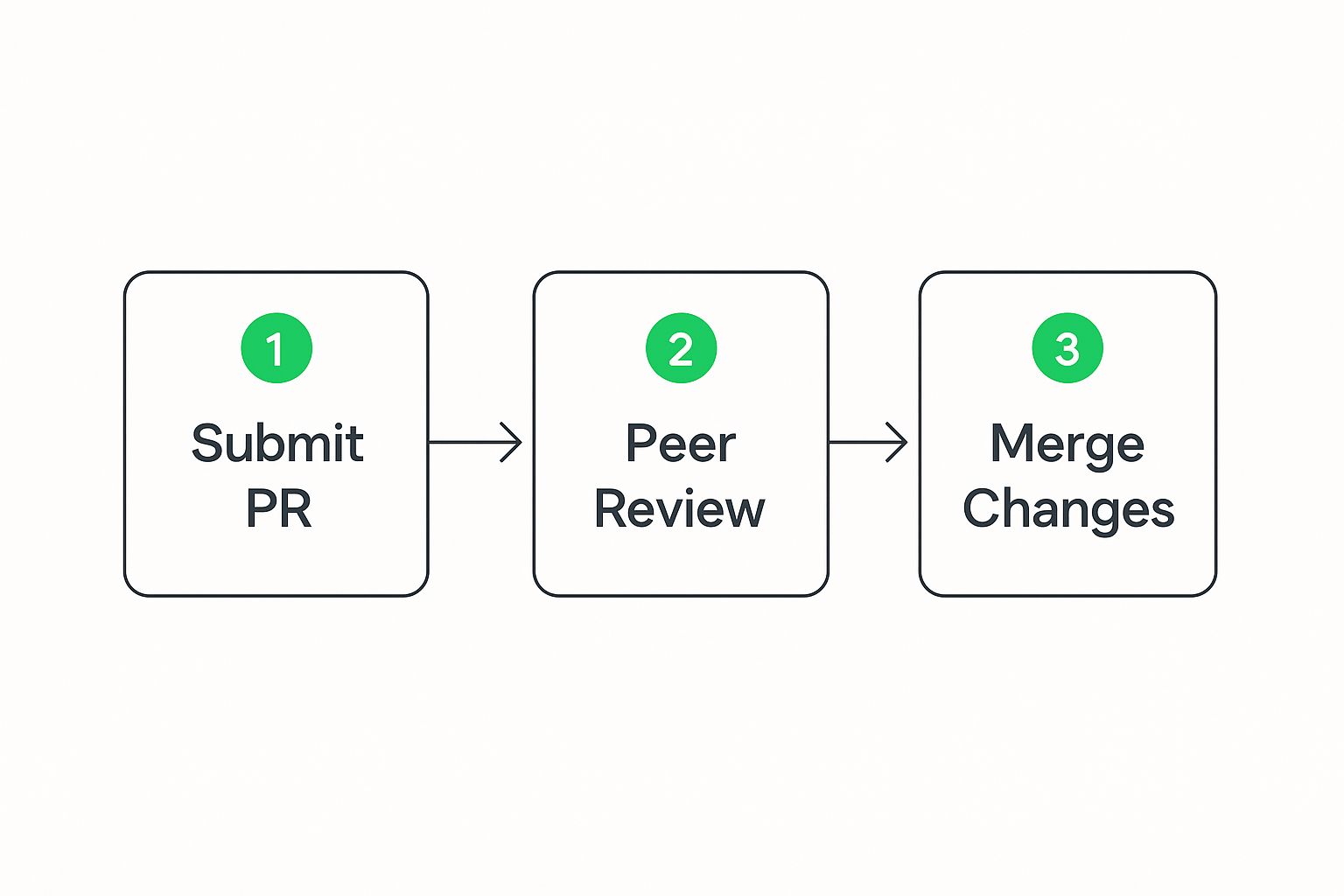What is code review and why is it essential? Explore the process, benefits, best practices, and tools that improve code quality and team collaboration.
Let’s get one thing straight: code review is a collaborative process. It’s not about pointing fingers or showing off. Think of it as peer editing for software developers. Before a new piece of code gets merged into the main project, a teammate—a fresh set of expert eyes—gives it a thorough look. It’s that crucial quality check designed to catch bugs and potential security holes before they ever see the light of day.

But code review is so much more than just a bug hunt. It’s one of the foundational pillars of building solid, high-quality software. It forces a structured moment for developers to share knowledge, align on team standards, and build a sense of collective ownership over the codebase. This is how it transforms from a simple task into a cultural cornerstone for any modern engineering team.
The industry has certainly taken notice. The global market for code review tools was valued at around USD 2.1 billion and is expected to more than double, hitting an estimated USD 5.3 billion by 2032. That’s a compound annual growth of 10.8%. If you’re curious, you can explore more data on the code reviewing tool market to see just how fast this space is growing.
While catching defects is a huge win, the real purpose is much bigger. A truly successful review process improves both the software and the team at the same time. It’s a system built to ensure every single line of code meets an agreed-upon standard of quality before it ever affects a user.
A well-run code review isn’t a free-for-all. It’s a focused effort targeting several key areas that lead to a healthier, more maintainable project. These objectives help reviewers give feedback that is genuinely constructive and makes a real impact.
Here’s a breakdown of what a good code review aims to achieve:
| Core Objectives of a Code Review | | :--- | :--- | | Objective | Description | | Improving Code Quality | The main event. This focuses on making the code more readable, logical, and efficient, which naturally cuts down on future bugs. | | Catching Defects Early | Finding and fixing a problem before it’s merged is vastly cheaper and less chaotic than dealing with it in production. | | Enforcing Consistency | This ensures all code follows the team’s established style guides and architectural patterns, keeping the codebase clean and predictable. | | Distributing Knowledge | Reviewers get a peek into different parts of the codebase, which breaks down knowledge silos and makes the whole team more resilient. | | Mentoring and Growth | It’s a natural setting for senior developers to mentor junior colleagues and for everyone to pick up new tricks and techniques from each other. |
Ultimately, these objectives work together to create a cycle of positive reinforcement. Better code leads to a more stable product, and a culture of learning and collaboration leads to a stronger, more capable team.

Putting a formal code review process in place does so much more than just clean up a single pull request. Think of it as a long-term investment in the health of your software and the efficiency of your team. The most immediate payoff is a direct hit against technical debt—that nagging feeling you get when you choose a quick fix over the right one, knowing you’ll pay for it later.
We’ve all been there: a bug slips into production, and fixing it is a frantic, expensive scramble. Catching that same bug before the code is even merged is a whole different story. By making code reviews a standard checkpoint, teams can spot and fix issues early on. This isn’t just about saving time and money; it’s about stopping security vulnerabilities dead in their tracks before they ever see the light of day.
While the technical wins are huge, the cultural shift that comes with code reviews is just as important. It naturally creates a mentorship environment where junior developers get a front-row seat to best practices and architectural decisions, helping them level up way faster.
This collaborative approach shatters information silos. Suddenly, knowledge about a critical part of the system isn’t locked away in one person’s head. When several people understand a piece of code, no single developer becomes a bottleneck. It builds a powerful sense of collective ownership over the product’s quality.
This shared mission is the very foundation of building a software development team that drives success, getting everyone pulling in the same direction.
A consistent review process is one of the most organic ways to enforce your team’s coding standards. Instead of gathering dust in a wiki, these standards are lived and breathed with every pull request. The result is a codebase that feels uniform and predictable, no matter who wrote it.
A cohesive codebase pays dividends in several ways:
At the end of the day, code review is more than just a box to check. It’s a catalyst for shipping better software and building sharper, more connected engineering teams.
Let’s break down the code review process. It’s more than just a technical handoff; think of it as a structured conversation that shepherds a piece of code from a developer’s machine into the main codebase. Each step is there for a reason: to guarantee quality, spark collaboration, and ultimately build a better product.
The whole thing kicks off the second a developer wraps up a task. But before asking for anyone else’s eyes, the first, most critical step is a self-review. The author becomes their own first critic, hunting for obvious mistakes, leftover debugging code, or logic that isn’t crystal clear. This simple act of self-scrutiny massively boosts the quality of the code going in and shows respect for the reviewer’s time.
Next up, the developer crafts a pull request (PR) or merge request. This isn’t just a code dump. It’s about setting the stage. A well-written PR description explains what the code does, why it’s needed, and how it gets the job done. This is the author’s chance to walk the reviewer through their thought process, which makes the actual review go much faster and smoother.
With the PR ready to go, the author picks one or more reviewers. The ideal reviewer knows just enough to understand the changes but still has a fresh perspective to catch things the author might have overlooked. It’s all about striking that perfect balance between domain expertise and a new set of eyes.
This infographic lays out the core journey of a pull request quite nicely.

As the visual shows, once submitted, the code enters a collaborative loop before it can ever be merged. This really highlights peer review as a non-negotiable quality gate.
So, what are reviewers looking for? They’re typically focused on a few key areas:
Feedback is where the real magic happens. This is the collaborative heart of the code review process. Reviewers leave comments and suggestions, and the author responds. This back-and-forth isn’t about pointing fingers; it’s a constructive conversation designed to polish the solution. The author tweaks the code, pushes new commits, and the cycle repeats until everyone’s on board.
As more teams go remote, adapting this workflow is more important than ever. If you’re looking for solid strategies on managing distributed teams effectively, this guide to hiring remote developers is a fantastic resource.
Once all reviewers give their stamp of approval, the author gets the green light. The final step is merging the pull request, officially integrating the new, battle-tested code into the main branch. This wraps up the workflow, leaving behind not just better code but also a smarter, more connected team.

Simply doing code reviews isn’t the same as doing them well. There’s a world of difference between a team just going through the motions and a team that has turned code review into a powerful ritual for improvement. It’s these proven best practices that separate a frustrating chore from a high-impact habit.
One of the single most effective changes you can make is to keep pull requests (PRs) small and focused. When a reviewer is staring down a PR with thousands of lines, it’s a recipe for reviewer fatigue. You get superficial, “looks good to me” approvals because a deep analysis is just too overwhelming.
By breaking down big features into smaller, self-contained chunks, authors make it infinitely easier for reviewers to provide precise, meaningful feedback. It’s a simple change with a massive payoff.
To keep human eyes on what matters—the logic, the architecture, the tricky edge cases—you have to get the robots to do the boring stuff. This is where automated linters and formatters come in.
These tools are brilliant at enforcing team-wide style standards for things like indentation, line length, or variable naming. By letting a machine handle the nitpicking, you remove all that subjective, and frankly, annoying feedback from the human-to-human interaction.
This frees up your team’s brainpower for the complex problems that only a human can solve. As a bonus, it makes the whole process faster and less contentious. Part of this automation mindset also means ensuring your team understands fundamental principles, like the nuances of HTTP methods like PUT vs PATCH, which are crucial for building solid, maintainable APIs.
At the end of the day, a code review process lives or dies by its culture. It’s absolutely essential to build an environment where feedback is seen as a gift, not an attack. The entire point is to make the code better, together—not to point fingers.
To make this a reality, teams need to agree on clear guidelines. Define what “good enough” means for a review and set expectations for turnaround times. This keeps the process moving and ensures everyone is on the same page. The impact of getting this right is huge; the global code review market was valued at over ****1.765 billion by 2033.
For a deeper look at building an efficient process, be sure to read our detailed guide on code review best practices.
Of course. Here is the rewritten section, following all your requirements for style, tone, and formatting.
Even with the best of intentions, a code review process can go off the rails. It’s surprisingly easy to fall into common traps—or anti-patterns—that can make reviews ineffective or, worse, downright toxic. Spotting these pitfalls early is the first real step toward building a review culture that actually works.
One of the biggest offenders is the “rubber-stamp” approval. You know the one: a reviewer gives a quick “looks good to me” without really looking. This almost always happens when they’re faced with a monstrously large pull request (PR). A change that touches thousands of lines is just too overwhelming to review properly, leading to tired eyes and missed bugs.
Then there’s the opposite problem: nitpicking. This is when a review gets completely derailed by trivial arguments over things an automated tool should be handling, like comma placement or variable names. It’s a massive waste of time and, frankly, breeds resentment. The focus shifts from solving real problems to winning a debate over personal style preferences.
Perhaps the most damaging pitfall, though, is when code reviews devolve into personal attacks. When feedback is used to criticize the person who wrote the code instead of the code itself, you create a toxic environment where developers become afraid to submit their work. It completely shatters the trust and psychological safety needed for a team to collaborate effectively.
To keep your reviews from turning into a minefield, your team needs to be proactive. Here are a few practical ways to get things back on track:
To make sure reviews are consistent and nobody skips the important stuff, many teams lean on standardized checklists. It gives both the author and the reviewer a clear roadmap, spelling out exactly what needs to be checked before a PR gets the green light. It’s a fantastic way to ensure nothing critical gets overlooked.
For a great starting point, grab our ready-to-use checklist for code review.
By actively calling out and fixing these common issues, you can transform your code review process from a source of friction into a genuine engine for better code and a stronger, more collaborative team.
Even when you’ve got the basics down, you’ll still run into practical questions once your team starts doing code reviews regularly. Let’s tackle some of the most common ones that pop up for developers and team leads. These are real-world answers to help you sharpen your team’s approach.
There’s no magic number here. The sweet spot usually lands between one or two thoughtful reviewers. It’s all about the quality of the feedback, not the sheer number of approvals. A single, focused reviewer who really digs in is worth far more than three who are just rubber-stamping the change.
For really critical or high-stakes changes, getting two sets of eyes is a great idea. It brings in different perspectives. For example, one person might look at the high-level architecture and system design, while the other can dive deep into the specific logic and implementation details.
Once you go past two reviewers, you risk “analysis paralysis.” Too many conflicting opinions can bog everything down without adding much real value. The trick is to pick reviewers who have enough context to give you genuinely useful feedback.
Both are fantastic for improving code quality, but they operate on completely different schedules.
Pair programming is a synchronous activity. It’s two developers, one workstation, writing and reviewing code together in real-time. The feedback is instant, which makes it perfect for gnarly problems or for mentoring junior developers.
Code review, on the other hand, is almost always an asynchronous process. A developer writes code on their own, then puts it up for their colleagues to review whenever they have a free moment. This gives reviewers time for more deliberate, deep thinking and works great for distributed teams across different time zones.
Think of it this way: pairing is about real-time creation, while code review is about structured, reflective quality control.
To keep things effective, aim to wrap up any single review session in under 60 minutes. This isn’t just a random guess; major tech companies have done the research and found that a reviewer’s ability to spot bugs drops off a cliff after about an hour. Concentration fades, and the quality of feedback takes a nosedive.
This time limit also sends a message to the person writing the code: keep your pull requests small! If a review consistently takes too long, it’s a huge red flag that the change is too big. As a rule of thumb, try to keep changes under 400 lines of code. If it’s bigger than that, break it down into smaller, more manageable chunks.
Yes. Absolutely. This is non-negotiable for a healthy engineering culture.
Code review is about ensuring quality for everyone; it’s not just a training tool for junior folks. When you make sure senior developers get their code reviewed too, it does a few amazing things for the team: